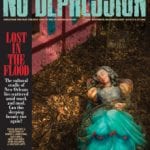Cherryholmes – A family’s flying leap into bluegrass
That last step might have played out very differently in some households, because the simple fact is, the Cherryholmes family was not raised in the bluegrass world at all. They had but the vaguest idea what the music even was as little as seven years ago — and the astonishing truth is that most family members had not even picked up an instrument, certainly not the ones they play today, or sung outside of church, before 1999.
In a story often told now, the Cherryholmeses — deeply committed evangelical Christians who oriented toward self-reliance and even survivalism and home-schooled their kids — reached a family crisis in ’99 with the death of their eldest daughter Shelly, at age 20, after her chronic heart problems. A casual trip to a bluegrass festival during the depths of their grief, and the closeness of the community and the spirit and musical fun spotted in the Jim & Jesse show onstage, led to Jere’s vision of forming a family bluegrass band to re-focus and energize them after their loss.
The family’s musical progression in the technically challenging genre since makes you wonder if they’d casually visited a medical convention whether they’d be a team of neurosurgeons now.
Sandy Lee started hitting the bargain record bins and the books, learning the original bluegrass repertoire. She’d studied music and theater growing up, and could read sheet music and play piano — but her interests had been more along the lines of Streisand-style pop and operetta.
Before the family bluegrass band was formed, Jere and Sandy Lee had a home keyboard studio where they were playing Celtic-oriented synthesizer music — shades of Enya and the Alan Parsons Project. (They’d been to a lot of Celtic festivals because Jere had been competing in Highland Games rock-tossing competitions!)
The band’s bluegrass teacher, Sandy Lee, and leader, Jere, were themselves students. For some time, what the band played and how they sang it was determined by what they could begin to handle.
Molly was first taught autoharp before moving on to fiddle when she was 6. Sandy Lee was learning bluegrass runs from standard texts, and teaching them to family members via piano even as she was learning chops on the mandolin herself. Since the family band needed a workable lineup of instruments, those were assigned, no arguments accepted. By all reports, Cia first found her banjo, and B.J. his fiddle, the worst choices imaginable. That, obviously, would change. The early introduction of dancing met some initial resistance too, but it’s an essential, memorable part of the act today, and everybody takes part.
Family musical prowess accrued through that relentless touring schedule, which really started to pile on in 2002. Mentors and influences including Jimmy Martin and the Vincents were encountered along the way, as audience response grew. The kids’ musical interests branched out to the likes of jazz fiddlers such as Stephane Grappelli to classical music — and, as their live twin-fiddle take on Bob Wills’ “Faded Love” shows, to western swing. A bit of the old Celt sounds and Sandy Lee’s prowess as a yodeler emerge onstage today as well.
Cherryholmes was never designed to be a gospel group — though, as with most trad bluegrass, there’s a set of testifying and praise songs within their shows. Their religious and moral sense does lead them to avoid certain venues and sorts of material — and for all their intensity, they place considerable emphasis on their desire to win larger audiences without falling prey to the familiar excesses of the pop music world. So there’s a lot of togetherness — on the bus.
In September, Jere had a crowd at Nashville’s Station Inn laughing about that: “I travel around with my family all the time. Seven days a week, 24 hours a day. And three of them are teenagers! Sitting on that bus after a fifteen-hour day, late at night, it was very easy to write a couple of murder ballads.”
Or, as Elvis-intense son B.J. puts it, “There are times where we just get sick of each other; we have to get away. A lot of bands tour 300 days out of the year, but they go home away from the rest of the band members the rest of the week!”
In fact, B.J. has become a fount of band ideas, in production and sounds. The Dirt Band’s “Workin’ Man” was turned into a harder-driving, old-timey/honky-tonk melange for the new CD at his suggestion, and he’s taking more vocal leads on tougher songs like that one now. Producer Ben Isaacs was impressed by bandleader Jere’s willingness to give all family members room to contribute ideas.
Today, the Cherryholmes kids are rising musicians in their own right, with quite sophisticated handles on bluegrass history and players. And just like their folks, their ambitions for the future are family-centered, unambiguous, and straightforwardly put.
“We mean to be the most popular bluegrass band in the country — while holding onto the values that we want to hold,” B.J. declares. “And we believe that we can make a difference in doing that.”




